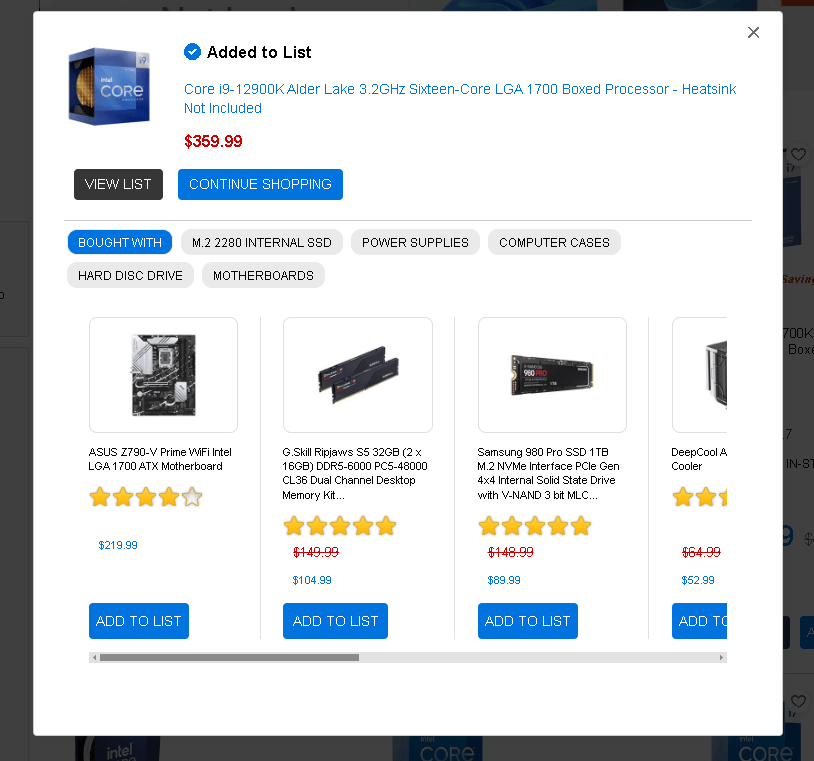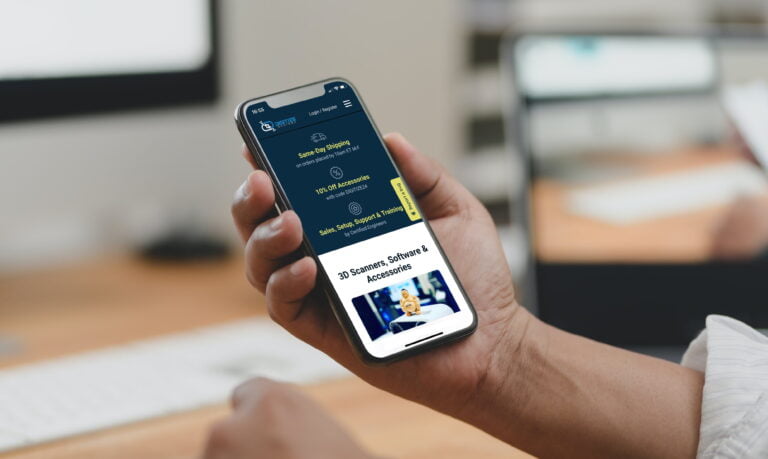
10 Most Effective Cross-Selling and Upselling Techniques for eCommerce
Intro
The customer journey does not need to end with a checkout. You can proactively use cross-selling and upselling strategies to unlock additional revenue streams and boost customer lifetime value.
According to Sucharita Kodali, a Principal Analyst at Forrester, cross-selling and upselling account for 10% to 30% of e-commerce revenue. Amazon reports reinforce this claim, stating that cross-selling and upselling bring up to 35% of their income.
These strategies also improve customer experience. Cross-selling and upselling techniques enhance the customer journey by suggesting products they might need and notifying them about discounts and other benefits.
In this post, we will outline our top eleven techniques for implementing cross-selling and upselling features in your eCommerce store to help you increase revenue and improve customer experience.
But first things first:
What is Cross-selling?
Cross-selling is a sales strategy of encouraging customers to purchase additional products or services besides their primary purchase. If your eCommerce business offers products that can enhance the initial purchase, cross-selling is an excellent strategy to increase your revenue.
We can illustrate cross-selling with the example of a PC hardware eCommerce store. Let’s say that a customer decides to buy a PC. The store can utilize cross-selling by offering complementary products like a monitor, mouse, keyboard, and speakers.
You can improve cross-selling effectiveness by offering a discount or free shipping to customers who buy an additional product.
Definition: Cross-selling is a sales strategy of encouraging customers to buy additional products complimentary to their main purchase.
What is Up-selling?
Upselling is a technique of encouraging customers to buy a premium version of their initial purchase. When utilizing upselling, you are not building around the customer’s initial purchase but offering a better version of the product/services they have previously agreed to buy.
To illustrate upselling, we can return to our example of an eCommerce hardware store. If a customer wishes to buy a laptop with certain specifications, a store can suggest purchasing a different laptop with better specifications at a slightly higher price.
Definition: Upselling encourages customers to purchase a better (and more expensive) version of a product or service that aligns with their needs and requirements.
The Difference Between Cross-Selling and Upselling
Although cross-selling and upselling are often used interchangeably, they are distinct sales strategies.
Cross-selling encourages customers to add lateral products or services that complement their initial purchase.
On the other hand, upselling involves offering customers a better version of the product or service they purchased.
If we return to our example of a PC hardware eCommerce store, cross-selling would be offering your customers a mouse and the laptop they purchased. On the other hand, if the store uses an upselling strategy, it will suggest a better product at a slightly higher price.
- Cross-selling is offering additional complementary products.
- Upselling is offering a better and more expensive product.
Should you Cross-Sell or Upsell?
There is no universal answer to this question. The effectiveness of the selling techniques may vary depending on your industry and your target audience’s buying preferences and habits.
At MANE Digital, we often use A/B testing as part of our conversion rate optimization services to evaluate the most effective solution for our clients. You can conduct A/B testing by creating two different landing pages, one including cross-selling and the other upselling. Then, divide your online shop’s traffic into two distinct groups. Group A will see the cross-selling page, while Group B will see the upselling option.
After a set amount of time, compare the conversion rates between the two groups and decide which approach is appropriate for your eCommerce store.
How to Implement Cross-Selling and Upselling
Upselling and cross-selling are versatile tactics you can apply throughout your eCommerce site for better sales results.
Some examples of implementing upselling and cross-selling into an eCommerce website include:
Sections on Landing Pages:
Sections on Homepage
Your homepage serves as a storefront for your eCommerce business. You can use it to promote your top products. When promoting the products on your homepage, use techniques such as social proof and include the products with the best reviews.
One example of cross-selling on your homepage is promoting a bundle of frequently bought products. Offering free shipping or a discount can increase bundled product sales even further.
To upsell, you can spotlight premium products and display them with positive user reviews.
Cross-selling and Upselling Sections on Product Pages
You can use cross-selling and upselling in your product pages to reduce decision fatigue, benefiting your customers and potentially increasing conversion.
For example, you can use cross-selling by implementing the You May Also Like section or upselling by showcasing high-tier options with positive reviews.
The section on the Cart Page
Shopping cart pages are an excellent place to introduce cross-selling.
Displaying complementary products on the shopping cart page (e.g., People Also Bought) may increase the average order value.
Pop-ups
You can also use pop-ups to apply cross-selling and upselling strategies.
For example, you can use timed pop-ups to upsell or cross-sell. Timed pop-ups can suggest premium products (upsell) or complementary products. As users’ time on a particular page indicates their interest, timed pop-ups can help increase conversion.
You can also use pop-ups on the cart page to recommend additional items.
However, it’s important not to overuse pop-ups to avoid negatively impacting customer experience and conversion.
Email marketing campaigns
You can also use cross-selling and upselling in your email marketing. For example, once customers purchase an item, you can suggest related products via email. You can also upsell a premium version of services your customer has bought.
Effective Cross-Selling and Upselling Techniques to use in eCommerce:
Now that we have briefly outlined cross-selling and upselling roles in different parts of the customer journey, let’s delve deeper into the most effective eCommerce techniques.
Our top choices include:
1. Employ Creative Product Bundling Techniques
Product bundling is one of the most popular cross-selling eCommerce strategies. It involves offering additional products that complement the main one and selling them as a single package.
If we return to our example of a computer hardware eCommerce store, we could create a product bundle by including a monitor, mouse, keyboard, sound system, and a main item (PC, in this case).
The eCommerce store could also offer additional benefits when buying bundled products to make the most of this cross-selling technique. For example, it could offer discounts or free shipping when purchasing bundles.
2. Recommend Complementary Products
An eCommerce site can also utilize cross-selling by offering related products. For example, an eCommerce hardware store can attempt to cross-sell a mouse when the customer is buying a laptop, as many people dislike using a touchpad.
You can use this strategy on your pages, pop-ups, and email marketing.
You can add a People Also Bought section to your pages displaying items often bought together. Amazon provides an excellent example of this approach:

As mentioned, you can also use pop-ups to recommend complementary products. Returning to our laptop example, an eCommerce store can use pop-ups when customers add a particular computer to their shopping cart. However, pop-ups are often seen as intrusive and can negatively affect customers’ experience. If you decide to use pop-ups, remember to use them sparingly.
Suggesting a complementary product via email is a low-risk application of this cross-selling technique. You can implement it by sending an automated email offering complementary products once the customer has bought an item. Statistics confirm the effectiveness of promoting products to your existing customers. According to Forbes, the likelihood of selling to a customer who has already bought your product is between 60% and 70%. In contrast, the conversion rate when promoting products to a new customer ranges between 5% and 20%.
3. Promote What Other Customers Also Bought
The technique described in the previous section should not be limited to product pages or shopping carts. You can use a similar approach in almost any part of a customer’s journey.
To make it even more general, cross-selling does not need to be tied to items customers buy together simultaneously. You can extend this approach to items that customers often purchase at any time. As many customers using your eCommerce store probably have similar tastes, promoting items that the same customers buy at any time can be an effective way to implement cross-selling.
In addition to the Frequently Bought Together sections, you can promote products using pop-ups. Cross-selling pop-ups on the checkout page can be effective as customers have likely already decided to purchase.
4. Personalized Offers Based on Customer History
The previous two approaches focus on customers without your eCommerce website’s search or purchase history. However, having access to customers’ histories enables even more effective cross-selling and upselling.
When using a customer’s browsing history, you can customize your cross-selling and upselling approaches to the preferences of a particular customer. For example, you can use sidebars or footers to display recently viewed items to increase the chance of conversion. Alternatively, you can utilize them to promote related products (cross-sell) or premium versions of their recently viewed product (upsell).
To illustrate this approach, we can use our previous example of Amazon:
In the picture above, Amazon uses our previous shopping data to upsell a premium product (article one) in our shopping cart. In addition to the recommended product, Amazon uses temporary discounts to create a sense of urgency and increase the likelihood of conversion.
5. Suggest Premium Products
You can utilize upselling techniques on your product pages or shopping carts to encourage customers to buy a superior version of the product or service they are viewing or intending to buy.
To make the most of this approach, you can provide detailed images and descriptions of a premium product that highlight its benefits relative to your customer’s initial search.
Once again, Amazon provides an excellent example of this upselling technique:

In the example above, Amazon compares similar items (in this case, low-end laptops) and gives recommendations for superior products. It encourages customers to buy a product by offering detailed specifications to demonstrate the superiority of the premium product. The “Compare with similar items” section also uses social proof (user ratings) for different recommended item characteristics to increase the likelihood of conversion.
6. Highlight Your Products With Customer Reviews
When trying to cross-sell and upsell, show products with many good reviews to increase the likelihood of conversion. User reviews serve as social proof and make customers more likely to buy a superior product or additional complementary products.
Social proof is the psychological effect of people being more likely to emulate others’ behaviors when uncertain about a decision. In the case of eCommerce, displaying the number of people who made a particular purchase and showcasing their reviews can increase the likelihood of conversion.
7. Recommend Products in a “Mini Cart”
Including mini carts significantly improves your customers’ user experience. It enables customers to see the items added to their cart as a sidebar or a pop-up without a need to go to the checkout page.
Mini carts are also an excellent tool for cross-selling. You can use the micro cart to promote related products and the items frequently bought together.
We can illustrate the usage of the micro cart in the example of a PC hardware eCommerce website:

In the example above, Micro Center uses a mini cart to promote related products. In this case, a mini cart suggests buying a motherboard and RAM complementary to the CPU that we added to our cart.
8. Provide Free Shipping Above a Specific Amount
Providing free shipping is also an excellent strategy to increase the likelihood of cross-selling and upselling techniques. That is especially true because the shipping cost is one of the main reasons for high cart abandonment rates.
By prominently displaying that your eCommerce store offers free shipping for purchases that exceed a set amount, you can stimulate customers to buy more products or to choose a more expensive option.
9. Create a Sense of Urgency When Upselling and Cross-Selling
You can create a sense of urgency to increase the chance of success of your cross-selling and upselling approaches.
Time-limited offers create a sense of urgency. For example, you can offer free shipping or a discount if a customer buys multiple or premium products within a set time.
Alternatively, you can offer the discount until you don’t sell a set number of products and add a countdown. It will create a sense of urgency while utilizing social proof.
To illustrate this approach, we can return to our previous example:

In the example above, a sense of urgency is used by offering a limited-time discount on a premium product to enhance the effectiveness of upselling.
10. Retargeting
You can also use retargeting to improve the effectiveness of your cross-selling and upselling. Retargeting is done by showing personalized ads to your customers based on their search history, previously bought products, and other data.
For example, when a customer buys a PC, you can show ads for a mouse or a headset. You can also use retargeting to upsell by promoting premium products to customers searching for a specific product (e.g., you can show ads for computers with better specifications).
To implement retargeting into your eCommerce store, you must segment your audience according to their demographic, purchase history, or browsing behavior and display recommendations based on their data.
11. Track Sales and Send Related Offers via Email
Cross-selling and upselling are not limited to your eCommerce website.
Email marketing is often also seen as one of the most effective cross-selling and upselling approaches, as the customers who are satisfied with your products are more likely to purchase from you again.
To cross-sell your product via email, you can send automated messages informing your customers about related products once they purchase. For example, if your customer buys a laptop, you can promote a mouse or headset via email.
You can also use emails for upselling. For example, if your customer has bought a low-end PC, you can later suggest component updates (such as more RAM or a better graphics card) via email.
Conclusion
The trend of rising customer acquisition costs is undeniable. Your eCommerce business should strive to get the most out of each transaction if you want it to stay competitive.
In this post, we have outlined our top methods to increase the value of each transaction by using cross-selling and upselling techniques while enhancing your user experience.



